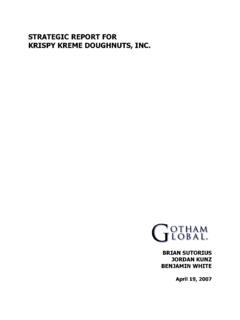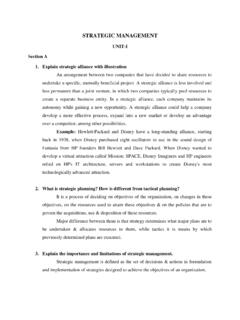Transcription of Strategic Report for Starbucks Corporation - Pomona
1 Strategic Report for Starbucks Corporation Harkness Consulting Innovation through Collaboration Harry Leshner Cathryn Camacho Scott Damassa April 14, 2007 Table of Contents Executive Summary ..2 Company History ..3 Competitive analysis ..5 Internal Rivalry .. 5 Entry .. 8 Substitutes and Complements .. 9 Supplier Power .. 10 Buyer Power .. 11 SWOT analysis ..11 Financial analysis ..12 Strategic Issues and Recommendations ..17 Appendix ..20 Harkness Consulting 1 Executive Summary Starbucks Corporation , formed in 1985, is a leading specialty coffee retailer and one of the best known brands todayi.
2 In addition to its sale of high quality coffees, Starbucks retail stores also offer Italian style espresso beverages, cold blended beverages, complementary food items, coffee related accessories and equipment, premium teas, and a line of compact discs. Outside of its company operated retail stores, Starbucks also sells packaged coffee and tea products, ready to drink beverages including its bottled Frappuccino beverages and Starbucks DoubleShot espresso drinks, ice creams, and other products mainly through licensing relationships. The company s brand portfolio includes Tazo teas, Starbucks Hear Music compact discs, Seattle s Best Coffee , and Torrefazione Italia coffee. Throughout its history, Starbucks has been known for its aggressive store expansion, as it seemed impossible to open new stores quickly enough to keep up with demand.
3 However, since its stock falling from about $80 per share near the end of 2006 to its current price of about $18 per shareii, along with a dramatic decline in the growth of its same store sales last quarteriii, it seems that Starbucks may have run out of growth opportunities. Furthermore, as other specialty coffee retailers such as Peet s Coffee and Tea and Caribou Coffee have entered the market, and as competition from fast food chains such as Dunkin Donuts and McDonald s has increased, Starbucks has lost market share. Therefore, it may appear that the company is in decline. Despite these conditions, Starbucks remains the strongest company in the industry and it has many opportunities to increase its profits. The major issues facing the company include maintaining the Starbucks Experience for customers, store expansion and real estate issues, competition from fast food chains and other specialty coffee retailers, specialty operations, generating more demand and penetrating new markets, and lowering input costs.
4 Since the return of Howard Schultz in January 2008, much has been done that addresses the first three issues mentioned. The analysis in this Report will help reaffirm those initiatives as well as discover others that address the last three issues and will enhance the company s performance. Harkness Consulting 2 Starbucks must seek more licensing relationships that will increase revenues from specialty operations at little cost, and also expose the brand. Existing retail stores must attract more customers and increase sales, especially after the morning rush hours, and can do so by expanding non coffee beverage options. Finally, the company will drastically reduce its input costs by abandoning purchases of Fair Trade CertifiedTM coffee, which can be accomplished without drawing negative attention to the brand.
5 Company History Starbucks began as a whole bean coffee seller in Seattle, Washington at Pikes Place in 1971iv. The original location s name was Starbucks Coffee, Tea, and Spices, This caused some confusion and was later shortened to the Starbucks Coffee Company. The name Starbucks comes from the first mate in the Moby Dick book by Herman Melville. Since its inception, the company s goal has been to find the premier coffee in the world and present it to people who would otherwise not be exposed to it. In 1982 Starbucks acquired the services of Howard Schultz as the director of retail operations and marketing and the company began to expand its businesses by providing coffee to fine restaurants and espresso barsv.
6 Starbucks put an emphasis on freshness during this time and would replace coffee it deemed not to be fresh, and thus unfit for consumption, for free so that customers received only the best coffee at these restaurants. A major shift in the Starbucks business plan occurred in 1983 when Schultz traveled to Italy and noticed the popularity of espresso bars in Milan. This gave him the idea that this would work in the United States, and Starbucks began testing this concept in 1985, successfully. In 1985, Schultz founded Il Giornalevi, which offered brewed Starbucks products in his Milan espresso bar replicas. Il Giornale succeeded and in 1987 Schultz secured the backing of local investors and acquired Starbucks Assets and changed the name to Starbucks Corporation .
7 From 1987 to 1992 Starbucks Corporation grew to 165 locations. This also included a mail order Harkness Consulting 3catalog, a new headquarters, airport locations, and deals with several airlines to serve coffee on board. On June 26th, 1992 Starbucks IPO d at a price of $17 per share and closed trading on the first day at $ per sharevii. SBUX common stock is traded on the Nasdaq exchange. Since then, Starbucks has been one of the leaders in stock incentive programs involving even its part time baristas. Starbucks was one of the first and still the most active companies in granting stock options to its entry level employees regardless of salary. This is one of the reasons that Starbucks has been able to have such a high level of service over the years, because its employees care about the public perception of the company.
8 From 1992 to 2000 the Starbucks Corporation continued to grow and flourish by increasing its store total to an astounding 3,501 stores. During this time the company acquired Tazo teas & Hear Music in 1999, in hopes that people would view Starbucks as a destination, instead of simply a coffee shopviii. Starbucks has continued to acquire companies in order to make the transformation from simple coffee bar to entertainment destination by offering high speed internet since 2001, and starting events for local artists and musicians in the recent years. Throughout the years Starbucks has grown its core business away from just coffee to a diversified portfolio including many different goods. The company s current product portfolio includesix: Over 30 blends and single origin coffees Unlimited combinations of brewed coffee and tea products Fresh foods; which includes pastries, sandwiches & salads Music, books, and film Packaged drinks and Starbucks liqueurs The Starbucks Card ($ Billion in activations and reloads since 2001) Harkness Consulting 4In addition to its extensive product offerings, the Starbucks Corporation has many brands which it cultivates including; Starbucks Entertainment, Starbucks Hear Music , Tazo Tea, Ethos Water, Seattle s Best Coffee , and Torrefazione Italia coffee.
9 The successful management of all of these brands pulled together represents the Starbucks portfolio in most Starbucks locations. Aside from products and brands, Starbucks is one of the most globally conscious corporations in America. In 2006 Starbucks donated $ million in cash and products, volunteered 383,000 hours in local communities, required growers to use strict environmental guidelines, used 20% renewable energy in stores, and actively recycled in almost 80% of stores in US and Canadax. Starbucks has established itself as the coffee leader in the world and has done so on a socially and environmentally conscious platform. Throughout the years, the company has been the industry leader in promoting conservation in its actions and its preaching to the rest of the world.
10 During this time, the company has surpassed all competition in this market because of its quality products and its focus on service. Starbucks has created a system of business where even the lowest paid employee is still encouraged to take pride in the company for which he works because it is tied to his compensation, which has helped to infiltrate the mission statement of Starbucks into all levels of employees. Competitive analysis Porter s Five Forces Summary for Starbucks Acting Force Level of Threat to Profits Internal Rivalry Mid Entry Low mid Substitutes and Complements Mid Supplier Power Low Buyer Power Low Internal Rivalry As the specialty beverage industry only grows more competitive, Starbucks dominant positioning with a large market share is continuously under pressure.













